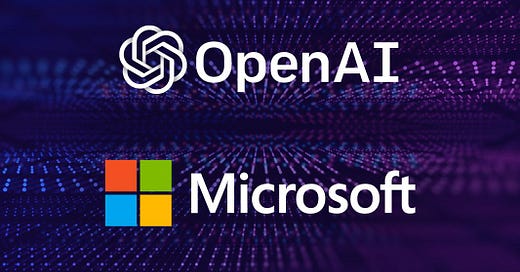
Microsoft doubles down on AI in ‘multi-billion dollar investment’
Microsoft really wants to use OpenAI's tech
Microsoft has once again thrown its weight behind artificial intelligence, with a multi-billion dollar investment in OpenAI with the hope it can “accelerate AI breakthroughs to ensure these benefits are broadly shared with the world”.
OpenAI is the research company behind the popular artificial intelligence image generator DALL-E and chatbot ChatGPT.
In a blog post, Microsoft said it has increased its investments in the development and deployment of “specialized supercomputing systems” to hasten OpenAI’s research. But the new partnership also makes Microsoft the exclusive cloud provider of OpenAI, meaning Microsoft’s proprietary cloud computing platform Azure will power “all OpenAI workloads across research, products and API services”.
➡️ The Shortcut Skinny: Microsoft backs AI
🔒 Microsoft has announced a huge investment in OpenAI
🏖 The AI research company is responsible for tools like ChatGPT and DALL-E
🙁 Microsoft said it plans to deploy those models in its own consumer products
💼 It’s far from the first significant investment Microsoft’s made in the tech
It’s a bet on OpenAI’s future growth, as well as a way for Microsoft to hitch its wagon to the AI researcher and attach itself to the foundation of the tech.
On top of that, Microsoft says it plans to “deploy OpenAI’s models across our consumer and enterprise products” that will “introduce new categories of digital experiences built on OpenAI’s technology”.
That will allow developers to build AI applications using OpenAI’s tools through Azure, but as The Information revealed earlier this month, Microsoft is also reportedly working on integrating aspects of the ChatGPT model into Word, PowerPoint and Outlook. It might not be long before we see AI-based features appearing in consumer-level Microsoft products.
Microsoft has made similar investments into OpenAI before. In 2019, the companies announced Microsoft would become OpenAI’s “preferred partner” for commercializing new AI technologies after Microsoft invested $1 billion, while in 2020 Microsoft purchased an exclusive license to GPT-3, letting it use the language model in its own software.
“We formed our partnership with OpenAI around a shared ambition to responsibly advance cutting-edge AI research and democratize AI as a new technology platform,” said CEO Satya Nadella. “In this next phase of our partnership, developers and organizations across industries will have access to the best AI infrastructure, models, and toolchain with Azure to build and run their applications.”
Microsoft hinted at its future investment in artificial intelligence when it laid off 10,000 employees last week and suggested “the next major wave of computing is being born with advances in AI”. Before that, it revealed its new text-to-speech AI, VALL-E, which can accurately simulate a human’s voice based on only three seconds of audio.
But the tech recently came under public scrutiny when CNET revealed it had been using AI engines to create SEO-friendly financial explainer articles. In fact, it had been publishing AI-created articles for nearly 18 months before anyone noticed, hiding them behind a generic byline so as not to disclose they were machine created. Readers and competitor writers have largely been critical of the practice, and despite assurances from CNET that all AI-generated articles are fact-checked by a human editor, issues as basic as simple math errors have slipped through.














